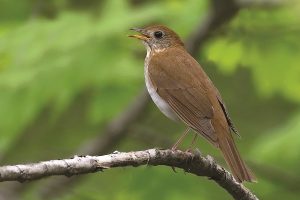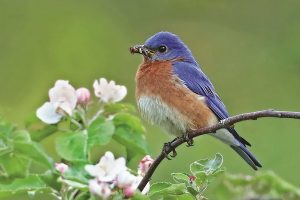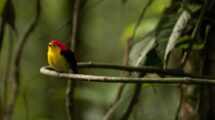Birding
Article & Photos By Brian Morin
Songbird virtuosos
 Outdoor activities that respect the social distancing that we have all been asked to do, has brought new meaning to how we view the wonderful things around us.
Outdoor activities that respect the social distancing that we have all been asked to do, has brought new meaning to how we view the wonderful things around us.
Almost all of us have thrushes living close by, maybe even in our yards, but not everyone stops to think about the family connection. Your backyard Robin is the most common thrush. It is found in a variety of habitats and thrives where we live because of the available food and nest sites. Our yards have an abundance of meal choices during their critical breeding season — a variety of insects and later, berries for variety — but these songbirds especially relish worms. There is a lot of protein in earthworms and growing chicks have an insatiable appetite. It is hard to believe that in only two weeks a young Robin can leave the nest (with a little continuing help from the parents) ready to begin its life as our friendly neighbourhood thrush.
Veery
What makes these plump, medium-sized songbirds, thrushes is apparent in their early days. Young Robins have spotted breasts, a feature our thrushes have at some point in their development. Even young bluebirds have spots and a number of species retain this feature as adults. Of course, young Robins and Eastern Bluebirds lose their spots when their feathers molt and they develop their rusty breasts.
Most thrushes spend a lot of time feeding on the ground, probing for insects. The Bluebird, however, prefers to perch on high, waiting for an insect to move before heading to the ground to retrieve it. The bird then returns to a perch to repeat the hunt.
As a family, thrushes have some of the most beautiful songs a bird can make. We are all familiar with the Robin’s cheery greeting, unless of course it is three-thirty in the morning, and you have to get up for work in a few hours.
The quality of our woodland thrush songs is flutelike and for those who can whistle some bird songs, these remain frustratingly out of reach. The songs are usually brief, sometimes with subtle variations as they repeat, and are usually uttered from deep within the forest. In fact, most of our thrushes are forest birds, occupying various habitats but thriving in forests that are extensive.
The Hermit Thrush and Swainson’s Thrush, two of the species with the most beautiful songs are birds of evergreen or mixed evergreen-deciduous forests, while the Wood Thrush can often be heard in deciduous woods as well. ‘Heard’ is the operative word because more often than not we hear these birds, but they remain hidden within their environment, their dull colours and spotted breasts helping to conceal them from prying eyes.
Learning the songs of our woodland thrushes is not only music to the ear, it also helps us to know who lives next door. Perhaps the most common species is the Veery. Its characteristic rusty, rather than brown, top colour and finer breast spots distinguishes it from other species and it occupies a variety of habitats. It will also show itself more often than its cousins. All of these woodland birds have a ritual of singing late in the day, sometimes even into twilight. As the evening sounds come alive, these sweet melodies signal the transition from day to night.
From the perspective of colourful thrushes, the Eastern Bluebird wins hands down. This bird ranks in the top tier of birding favourites and is a prized catch for those who put up nest boxes hoping to attract these special tenants. Your success will be enhanced if the setting is rural and the adjacent habitat is open uncultured land. Pastures are picture perfect, supplying the necessary insects in an area where the grasses and wildflowers are controlled by feeding cattle. Hayfields and fallow land are also excellent.
There are even Bluebird ‘trails’ in parts of Eastern and Central Ontario. Bluebird houses have been erected along many kilometres of rustic country roads by thoughtful birders in cooperation with landowners. The Perth-Smiths Falls area in the Rideau Corridor ranks among the better locations in the province to see this.
 To increase breeding success and reduce competition from Tree Swallows, two boxes are erected, about five metres apart, separated by about 100 metres. Supporting Tree Swallows is equally beneficial because these birds, too, need all the help they can get. The more aggressive swallows will not accept another of their kind living next door, but Bluebirds are tolerated.
To increase breeding success and reduce competition from Tree Swallows, two boxes are erected, about five metres apart, separated by about 100 metres. Supporting Tree Swallows is equally beneficial because these birds, too, need all the help they can get. The more aggressive swallows will not accept another of their kind living next door, but Bluebirds are tolerated.
Eastern Bluebird
While you may see small flocks of Robins and bluebirds in migration, you will never see a flock of woodland thrushes like the Veery and Hermit Thrush. These birds are solitary and for the most part secretive. You will need to be content with the occasional sighting from mid-May through early fall and of course listening to their hauntingly beautiful songs. Isn’t it wonderful to be in spring again?
Brian Morin is the publisher of Ontario Birding News, a newsletter for birding enthusiasts. He has been actively involved in watching and
photographing birds in Ontario for more than 40 years.






